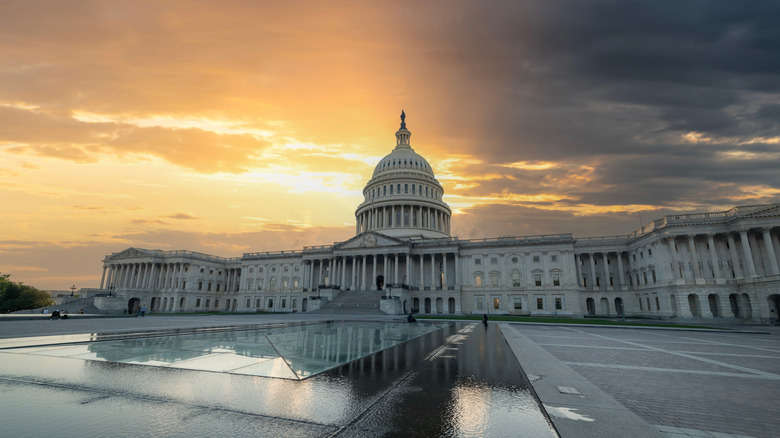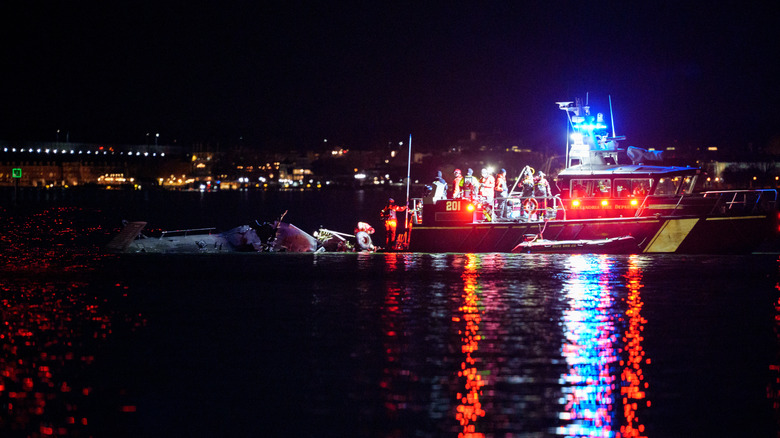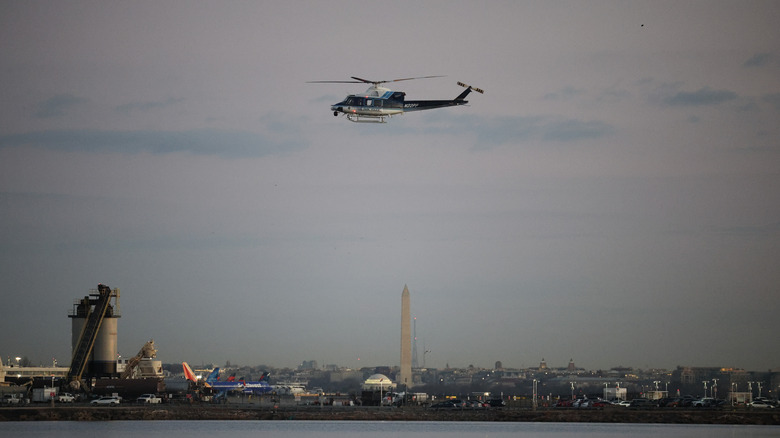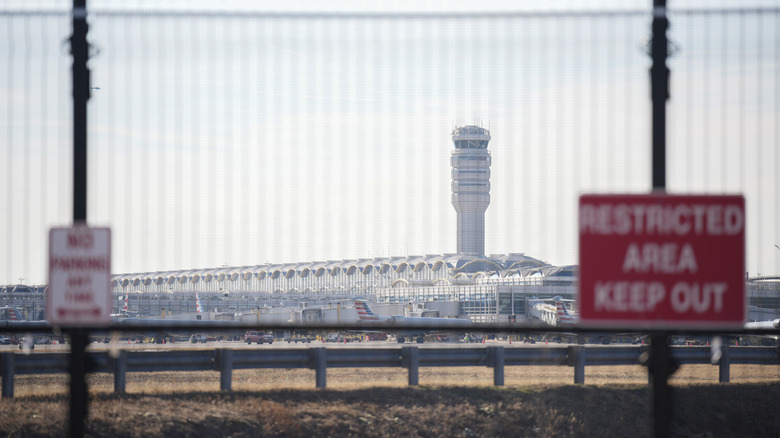The Biggest Questions About The 2025 DC Plane Crash
The United States currently stands in mourning over the collision of American Airlines Flight 5342 and a UH-60 Blackhawk helicopter above the Potomac River in Washington, D.C. The crash happened at about 8:47 p.m. on January 29, 2025 as the commercial plane was coming in for a landing at Ronald Reagan Washington National Airport (DCA). The incident is America's first major commercial air collision since 2009 and the deadliest plane crash since 2001. Sixty-seven died in total — everyone on both aircraft — and at last count, 40 bodies have been recovered. Investigations have more or less just begun, and numerous questions remain.
Looking to the basic facts of the event and steering far from speculation, accusations, and conspiratorial chatter, American Airlines Flight 5342 left Wichita, Kansas for Washington, D.C. at 6:39 p.m. on the night of the crash. As a smallish, Bombardier CRJ-701 twin-engine plane, the plane was at near-full capacity. By the time the flight was approaching DCA at about 8:42 p.m., air traffic control redirected it from Runway 1 to Runway 33 — a standard procedure.
At the same time, a Blackhawk helicopter was conducting military training in the area. Since both civilian and military helicopters fall under the purview of the Federal Aviation Administration (FAA), air traffic control at DCA contacted the helicopter (callsign PAT 2-5) and tried to redirect it away from the path of Flight 5342. This is where things get unclear. The Blackhawk didn't veer away — in fact, it raised its altitude above its mandated 200 feet, and the two aircraft collided in a ball of flame.
Why didn't the helicopter heed air traffic control's warnings?
In trying to understand why the recent mid-air plane collision above Washington, D.C. happened, one question stands out: Why didn't the helicopter heed air traffic control's warnings? Audio records indicate that air traffic control at Ronald Reagan Washington National Airport (DCA) and the Blackhawk were in communication leading up to the crash, even within 30 seconds of it happening. On CNN, we can hear air traffic control ask the Blackhawk, "PAT 2-5 [the callsign], do you have the CRJ [commercial jet] in sight?" Air traffic control then makes a command rather than asking a question: "PAT 2-5 pass behind the CRJ."
At this point, the Blackhawk replies, "PAT 2-5 has aircraft in sight, request visual separation." As the FAA explains, "request visual separation" means that a pilot wants a route, or instructions, to safely get away from another aircraft. The natural, logical assumption is that the Blackhawk pilot couldn't see where Flight 5342 was, or couldn't see clearly enough. On Sky News Australia, Captain Byron Bailey talks about the difficulties of seeing things at night and remaining "situational aware" in chaotic and confusing situations. Former National Transportation Safety Board (NTSB) investigator Greg Feith seemed to agree when speaking with NBC News.
Meanwhile and relatedly, pilot, veteran, and Washington D.C. resident Bill Johnson asks the common sense question on The Guardian: "There's so many places they could have been doing training. Why did they have to do it at the end of the runways of DCA?"
Why was the helicopter above its regulated altitude?
We mentioned that the Blackhawk rose above its mandated, 200-foot elevation before colliding with American Airlines Flight 5342. A handy visual on CNN shows the precise routes of both aircraft leading up to their collision, which illustrates exactly how improbable and unlucky it was. Flight 5342 had turned from its main flight path and redirected itself towards Runway 33 at Ronald Reagan Washington National Airport (DCA), while the Blackhawk kind of zigzagged a bit over the Potomac before veering directly into Flight 5342. And it rose in elevation before this happened — otherwise the two aircraft might not have hit each other.
As AP News says, the maximum FAA elevation for the Blackhawk's path over the Potomac near the Woodrow Wilson Bridge — officially "Route 4" — is 200 feet. Descending commercial craft will of course start at a higher elevation on their way in for a landing, as Flight 5342 did. CNN shows that the flight was past the most dangerous part of its descent and very, very close to landing on the ground. On Sky News Australia, Captain Byron Bailey explains that this is the point in a flight where the landing gear is out, the pilot's eyes are straight ahead at the runway, and touchdown is imminent.
According to AP News, analysis of route maps and radar data indicates that the Blackhawk was at 300 feet at the time of the crash — 100 feet above the 200-foot limit. CBS News cites FlightAware and FlightRadar24 data that places the helicopter at a higher altitude of 375 to 400 feet. But either way, the same question remains: Why?
Were there any problems at air traffic control?
There are a lot more questions we could ask about the recent Washington, D.C. aircraft collision, and many more to come. But one more pertinent and obvious question stands out at the moment: Was there anything wrong or unusual going on at aircraft control? As far back as February, 2024, the Tim Kaine website reported that Senators Mark Warner, Tim Kaine, Ben Cardin, and Chris Van Hollen objected to the Senate Commerce Committee's decision to shuffle more flights to Ronald Reagan Washington National Airport (DCA). They called it a "profoundly reckless decision" because "DCA's runway is already the busiest in the country." According to Stratos Jets, the FFA ranked DCA No. 23 out of 200 airports in terms of numbers of passengers in 2022, but that doesn't account for staffing ratios, number of runways vs. number of flights, etc.
Fast-forward to the recent disaster and ABC 7 Chicago reports that DCA was having staffing problems, and that staffing in its air traffic tower on the night of the flight was "not normal." In fact, across the entire United States, the number of air traffic control staff dropped by 9% from 2011 to 2023. On NBC News, former National Transportation Safety Board (NTSB) investigator Greg Feith also said that there was one air traffic controller on duty on the night of the crash, not two. And given visibility problems at night and nothing but little cues (like green wingtip plane lights), any problems at air traffic control get compounded. While we're not certain of any air traffic control issues beyond this, such complications would doubtlessly make airfields and their airspace more dangerous than not.



